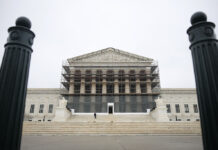Immigration Matters is a recurring series by César Cuauhtémoc GarcÃa Hernández that analyzes the court’s immigration docket, highlighting emerging legal questions about new policy and enforcement practices.
Please note that the views of outside contributors do not reflect the official opinions of SCOTUSblog or its staff.
Earlier this month, the Department of Justice filed an emergency request asking the Supreme Court to stay a temporary order from a district court blocking immigration agents in the Los Angeles metropolitan area from using an individual’s “apparent ethnicity,†speaking Spanish or accented English, location, and occupation to determine who might be violating immigration law. To support its arguments in Noem v. Vasquez Perdomo, the DOJ cites a half-century-old decision, United States v. Brignoni-Ponce,  which permitted immigration agents to consider an individual’s ethnic appearance in law enforcement actions.
The background
After the Department of Homeland Security launched widespread, highly publicized immigration law enforcement actions in and near Los Angeles, advocacy groups and several individuals sued DHS, claiming that immigration agents were stopping and arresting people in violation of the Fourth Amendment’s prohibition of “unreasonable searches and seizures.†The challengers, including U.S. citizens and unauthorized migrants, allege that immigration agents detained them, sometimes violently, because of their race, the location in which they spend time, their chosen line of work, or use of Spanish or accented English.
For example, Jorge Luis Hernández Viramontes, a U.S. citizen, is the manager of a carwash. He was at work when immigration agents arrived, for the second time that day, in unmarked vehicles and began questioning his employees. When Hernández Viramontes asked for a warrant, he claims an agent responded, “Shut the fuck up.†Even though he provided agents with his California driver’s license, agents arrested Hernández Viramontes and took him to a nearby warehouse for questioning.
Another U.S. citizen, Jason Brian Gavidia, was repairing his car in a tow yard when armed agents, some of whom were masked, arrived. He says he told them that he is a U.S. citizen who was born in Los Angeles, but agents took his state-issued identification card and detained him anyway.
Three other men, all Latino construction workers, were drinking coffee outside of a donut shop as they waited for a ride to a job site when masked men carrying long guns jumped out of cars with tinted windows and no license plates. One of the men tried to leave but was surrounded and arrested before he could. Another ran and was arrested. A third remained where he was standing and was also arrested.
U.S. District Judge Maame Ewusi-Mensah Frimpong issued a temporary restraining order in favor of the challengers on July 11. Frimpong’s order bars immigration agents from stopping someone unless they have reasonable suspicion that the person has violated federal immigration law. The order also prohibits agents from using four factors to determine reasonable suspicion, either alone or in combination: “apparent race or ethnicityâ€; “[s]peaking Spanish or speaking English with an accentâ€; “presence at a particular location†– such as a bus stop or car wash; and “the type of work one does.†Frimpong’s order applies only in the Central District of California, a region that includes approximately 20 million people in Los Angeles and surrounding counties. Over 47% of the district’s residents identify as Hispanic or Latino, the U.S. Court of Appeals for the 9th Circuit later noted.
The court of appeals largely rejected the government’s request for a stay of Frimpong’s order, explaining that it does not stop agents from using these factors in combination with others.
The DOJ’s emergency application
On Aug. 7, the government filed an emergency appeal, seeking to put Frimpong’s order on hold. In its request to the Supreme Court, the DOJ argues that the Fourth Amendment permits agents to rely on the four factors described above to gauge who might be violating immigration law. The government claims that “1 in every 10 people†who live in the Central District of California are violating immigration law. Under those circumstances, a person’s apparent race or ethnicity, their use of Spanish or accented English, where they happen to be, and their type of work “can heighten the likelihood that someone is unlawfully present in the United States,†contended U.S. Solicitor General D. John Sauer.
Particularly notable in the government’s brief is that, for support, it relies on United States v. Brignoni-Ponce, a 1975 decision in which the Supreme Court concluded that “Mexican appearance†is a permissible factor in the reasonable suspicion analysis required by the Fourth Amendment. Writing for his colleagues in Brignoni-Ponce, Justice Lewis Powell recounted that two federal Border Patrol agents stopped a vehicle near San Clemente, California, roughly 75 miles north of the U.S.-Mexico boundary, solely because “its three occupants appeared to be of Mexican descent.†The court unanimously concluded that, standing alone, the appearance of Mexican descent is not sufficient for Border Patrol agents to reasonably suspect that a person is violating immigration law, but “the likelihood that any given person of Mexican ancestry is an alien is high enough to make Mexican appearance a relevant factor†to justify stopping them. To identify people who look Mexican, Border Patrol agents were trained to use “such factors as the mode of dress and haircut,†Powell added.
In the decades that followed, lower courts largely cabined Brignoni-Ponce’s reach. The 9th Circuit undercut Brignoni-Ponce’s relevance by pointing to the Supreme Court’s use of statistical data from the 1970 U.S. census. The 9th Circuit described the court’s population data for residents of the Southwestern border states as “now-outdated demographic information†given that “[t]he Hispanic population of this nation, and of the Southwest and Far West in particular, has grown enormously-at least five-fold in the four states referred to in the Supreme Court’s decision.†The court of appeals also noted that, since the court’s ruling in Brignoni-Ponce, “[t]he use of race and ethnicity†in “government decision-making … has been severely limited.â€
It is true that, since the Supreme Court has never reversed Brignoni-Ponce, lower courts still cite to it occasionally. But, in doing so, such courts do not typically focus on the “Mexican appearance†factor. Rather, they reiterate that the Fourth Amendment requires immigration agents to have reasonable suspicion that the passengers of a vehicle are violating immigration law before stopping them.
The government’s recent stay application nevertheless seeks to revive Brignoni-Ponce’s embrace of ethnic appearance. The DOJ argues that, under Brignoni-Ponce, immigration agents may consider “a person’s appearance†or “apparent ethnicity†to determine reasonable suspicion. Indeed, the government contends that “no particular circumstantial factor is categorically off-limits†to the reasonable suspicion analysis. Siding with the Trump administration in a friend-of-the-court brief, the Federation for American Immigration Reform claims that factors like ethnicity “obviously are probative of reasonable suspicion.†Neither the DOJ nor FAIR explains how agents determine ethnicity, and if it is appropriate to do so through such factors as one’s “mode of dress and haircut.â€
In their response, the individuals and organizations challenging the Trump administration’s immigration operations focus on the Justice Department’s position on the detentions by federal officers based on ethnic appearance. They argue that allowing immigration agents to target people because of how they look “would promote blatant racial profiling.†Los Angeles and a group of counties and cities located in the Central District of California add in their own friend-of-the-court brief that “[t]he government’s suggestion that every person who works in construction, appears Latino, and speaks Spanish is somehow reasonably suspected of being in the country illegally is breathtaking in its scope, and heartbreaking in how far it departs from the American ideal.â€
The government’s request is currently before Justice Elena Kagan. As is common with emergency requests, the court has given no indication of how or when it will reach a decision. But if the court sides with the DOJ, the racial, ethnic, and linguistic diversity that characterizes the nation’s urban centers will effectively become powerful tools in the Trump administration’s approach to immigration law enforcement.
Cases: Noem v. Perdomo
Recommended Citation:
César Cuauhtémoc GarcÃa Hernández,
The Trump administration puts ethnicity on the court’s emergency docket,
SCOTUSblog (Aug. 19, 2025, 11:00 AM),
https://www.scotusblog.com/2025/08/the-trump-administration-puts-ethnicity-on-the-courts-emergency-docket/




